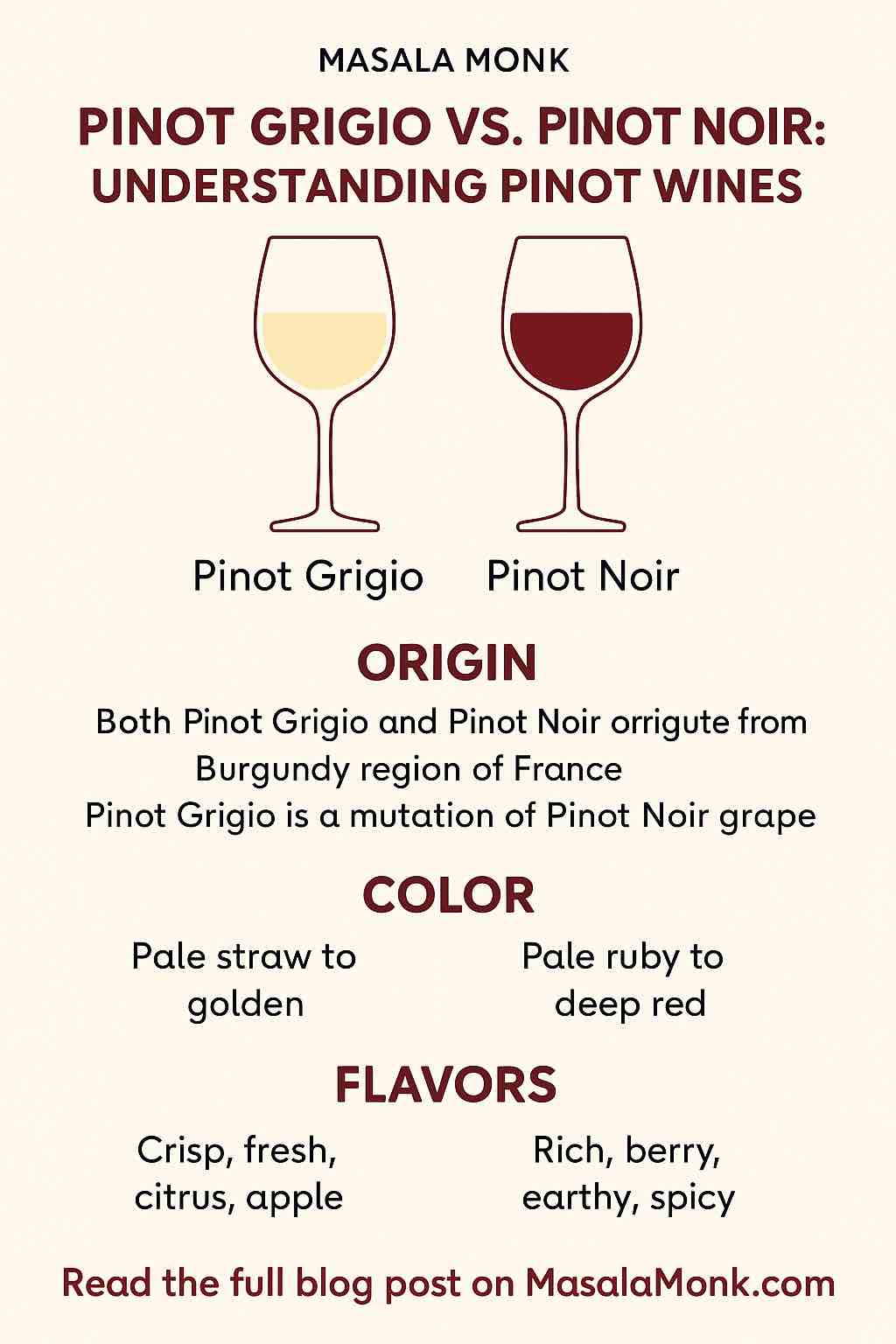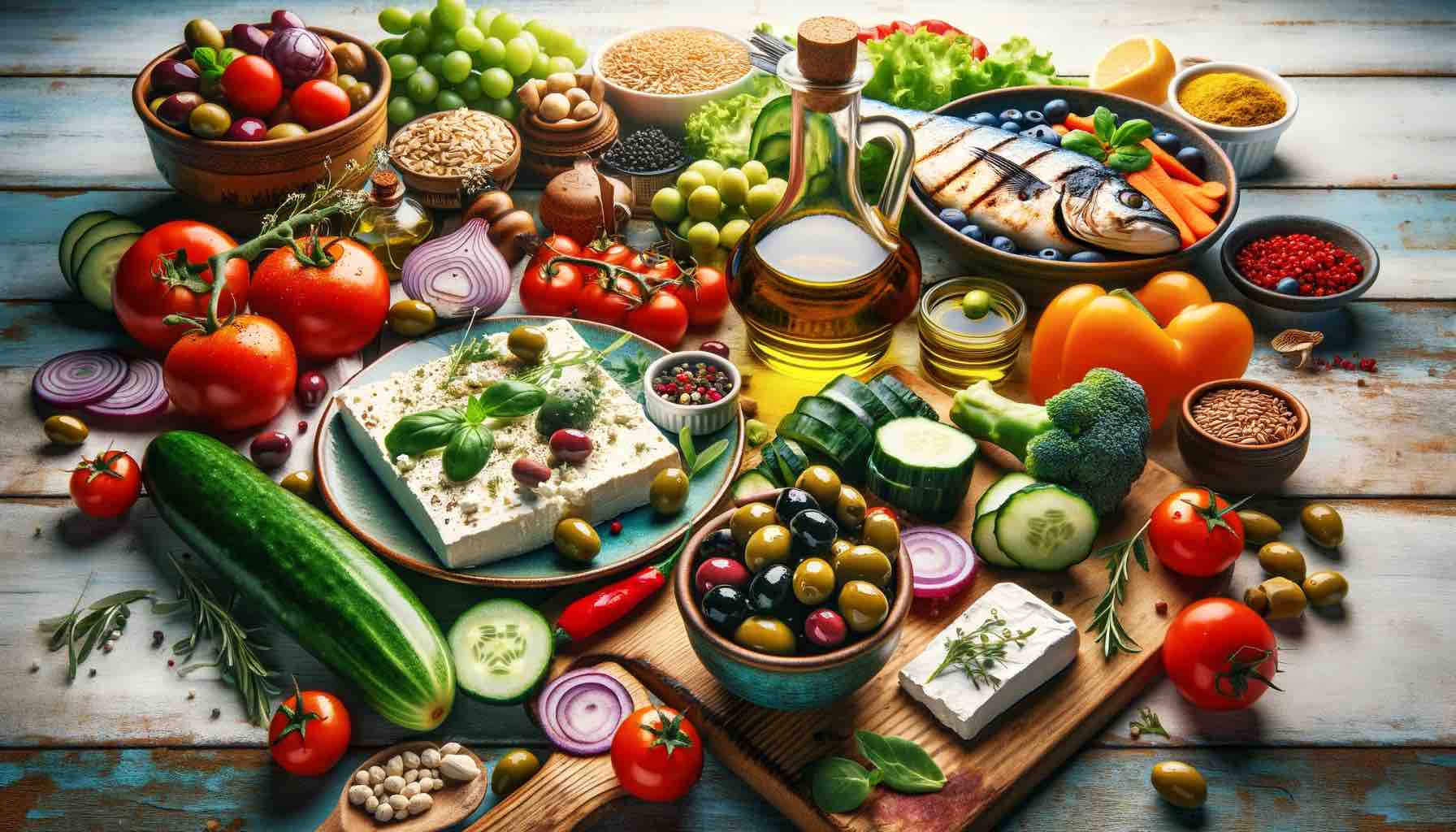
Wine lovers know the word “Pinot” signals something special—but what does it really mean when you see Pinot Grigio on a summer table or Pinot Noir poured at a dinner party? Though these grapes share a family name and a French heritage, they offer radically different drinking experiences. Let’s explore what makes Pinot Grigio and Pinot Noir so distinct, why they’re both having a moment in 2025, and how you can get the most out of each, no matter your taste or budget.
The “Pinot” Connection: Family, Mutation, and Diversity
Pinot refers to a family of grapes that originated in Burgundy, France, thousands of years ago. The most famous are Pinot Noir (red) and Pinot Gris (aka Pinot Grigio, white/rosé). Despite their differences in color and style, these grapes are genetically linked—Pinot Gris/Grigio is a natural mutation of Pinot Noir.
Key takeaway:
They’re siblings, not cousins—so if you like one, don’t be afraid to try the other!
Pinot Grigio: The Ultimate Refreshment (and Why It’s Trending Now)
What is Pinot Grigio?
Pinot Grigio is the Italian name for Pinot Gris, a grape known for its grayish-pink skins (gris means “gray” in French). The wine it produces is almost always white, though “ramato” (copper-hued) versions exist.
Typical Flavors:
- Italian: Zesty lemon, lime, green apple, pear, sometimes a hint of almond.
- Alsace/New World: Riper peach, apricot, honey, even subtle smokiness.
Body & Acidity:
Usually light, crisp, and high in acidity—think “thirst-quenching.”
Why It’s Popular in 2025:
- Major comeback: Pinot Grigio sales in the US grew by 11% in 2023 despite a general wine market decline.
- Younger drinkers are seeking low-alcohol, fresh, easy styles—Pinot Grigio delivers.
- California and Oregon winemakers are experimenting with more expressive, fruit-driven versions. Don’t sleep on these!
How to Serve:
Ice cold (45–50°F / 6–10°C) in a white wine glass. Great for patios, picnics, and light meals.
Best Food Pairings:
Shellfish, sushi, Caprese salad, chicken piccata, light pastas, or even Thai takeout.
Pro Tip:
Try “ramato” style Pinot Grigio from Friuli, Italy. Its copper tint and extra texture make it stand out at a dinner party.
Pinot Noir: Elegance in a Glass
What is Pinot Noir?
Pinot Noir is a thin-skinned, finicky red grape famous for its role in Burgundy’s legendary reds. Its wines are light to medium in color and body, but can be surprisingly complex.
Typical Flavors:
Cherry, raspberry, strawberry, sometimes floral, mushroom, earthy “forest floor,” or even truffle in aged bottles.
Body & Acidity:
Light to medium body, low tannins, and refreshing acidity—Pinot Noir rarely weighs you down.
2025 Trend Alert:
- Cool-climate Pinot Noir is hot: Think Oregon, New Zealand, coastal Chile, and even England.
- Chillable reds are “in”—young Pinot Noir can be slightly chilled for summer.
- Premium still Pinot Noir from England is winning awards and turning heads. Keep an eye on Sussex and Kent.
How to Serve:
Slightly cool (55–62°F / 13–17°C) in a large “Burgundy” glass for maximum aroma.
Best Food Pairings:
Roast chicken, duck, salmon, mushrooms, pork, even grilled tuna or pizza with earthy toppings.
Pro Tip:
Buy from newer regions like Chile’s Maule Valley or South Africa’s Hemel-en-Aarde for top quality at mid-range prices.
Side-by-Side: Pinot Grigio vs. Pinot Noir
| Feature | Pinot Grigio / Gris | Pinot Noir |
|---|---|---|
| Grape Color | Pinkish-gray (white wine) | Red (red wine) |
| Flavors | Citrus, pear, green apple (Italy); peach, honey | Red fruits, floral, earthy, subtle spice |
| Body/Acidity | Light, zesty, crisp | Light to medium, silky, vibrant acidity |
| Alcohol | 11–13% | 12–14.5% |
| Main Regions | Northern Italy, Alsace, Oregon, Germany | Burgundy, Oregon, California, NZ, Chile |
| Food Pairing | Seafood, salads, light dishes | Chicken, duck, salmon, mushrooms, pork |
| Style | Dry, refreshing, sometimes richer (Alsace) | Elegant, complex, delicate, sometimes bold |
2025 Buying Guide: What’s Hot Right Now?
Pinot Grigio
- Delle Venezie DOC (Italy): Classic, crisp, mineral-driven.
- Friuli-Venezia Giulia (Italy): Ramato, textured, skin-contact styles.
- California/Oregon: Fruitier, with notes of melon and citrus zest.
- Top Producers: Santa Margherita, Jermann, Scarpetta, Alois Lageder.
Pinot Noir
- Burgundy (France): The gold standard, but pricey.
- Oregon (Willamette Valley): Elegant, great value.
- New Zealand (Central Otago, Marlborough): Vivid fruit, structure.
- Chile (Maule, Casablanca): Cool-climate bargains.
- England: Emerging, with “still” Pinot Noirs showing finesse.
- Top Producers: Domaine Drouhin, La Crema, Cloudy Bay, Storm (SA), Laberinto (Chile).
The Science: Why Are They So Different?
- Climate Sensitivity: Both grapes do best in cooler climates. Heat can strip Pinot Grigio of freshness and make Pinot Noir flabby or jammy.
- Skin Thickness: Pinot Grigio’s thin, pink skin gives little color; Pinot Noir’s red, thin skin provides light color and gentle tannin.
- Winemaking Style: Pinot Grigio often sees little or no oak; Pinot Noir sometimes ages in oak barrels for depth and complexity.
- Terroir Translation: Both are “transparent” to their terroir—soils and climate come through clearly.
Practical Tips for Wine Lovers
- Want a crowd-pleaser? Pinot Grigio’s crispness and neutrality make it perfect for parties and hot weather.
- Hosting a dinner? Pinot Noir’s complexity and versatility make it the ultimate “food wine.”
- On a budget? Look to lesser-known regions (Chile, South Africa, Eastern Europe) for Pinot bargains.
- Into natural wine? Both Pinots are used by minimal-intervention winemakers for skin-contact (“orange”) and low-sulfite bottlings.
What’s Next? Trends to Watch
- Skin-contact Pinot Grigio (“orange wine”): For fans of texture and something a little funky.
- Sustainability: More organic, biodynamic Pinot vineyards in 2025 than ever before.
- Low-alcohol options: Winemakers are dialing down ripeness and alcohol, especially for Pinot Grigio.
- Premium single-vineyard bottlings: Both grapes increasingly used for high-end, terroir-focused wines.
Final Thoughts: Why Not Both?
Pinot Grigio and Pinot Noir prove the “Pinot” family’s genius. One is a zesty, casual refresher. The other, a nuanced, food-loving red. You don’t have to choose—keep both in your cellar (or fridge) and let the moment decide.
Practical challenge:
Next time you’re at the wine shop, grab one of each. Chill the Pinot Grigio for a sunny lunch; save the Pinot Noir for a cozy dinner. Taste them side by side and see how each brings out the best in food—and in you.
What’s your favorite Pinot experience? Have you tried ramato Pinot Grigio, or a Pinot Noir from an unexpected place? Share your stories below—let’s toast to the ever-evolving world of wine!
10 FAQs About Pinot Grigio vs. Pinot Noir
1. What’s the main difference between Pinot Grigio and Pinot Noir?
Answer: Pinot Grigio is a white wine (made from a pinkish-gray grape), while Pinot Noir is a red wine (made from a thin-skinned red grape). Their flavor profiles, food pairings, and wine styles are quite different.
2. Can Pinot Grigio and Pinot Noir be grown in the same regions?
Answer: Yes, both grapes thrive in cool climates and can be grown in places like Oregon, New Zealand, northern Italy, and France. However, they often show distinct characteristics depending on the specific region and winemaking approach.
3. What food pairs best with Pinot Grigio?
Answer: Pinot Grigio is ideal with seafood, salads, light pasta, chicken, and fresh cheeses. Its crisp acidity makes it great for refreshing, simple dishes.
4. What food pairs best with Pinot Noir?
Answer: Pinot Noir matches well with roast chicken, duck, salmon, mushrooms, pork, and earthy vegetarian dishes. Its versatility makes it a top choice for meals with multiple courses or mixed dishes.
5. Is Pinot Grigio always dry?
Answer: Most Pinot Grigio is dry, especially Italian styles. However, Pinot Gris from Alsace and some New World versions can be slightly off-dry or even medium-sweet.
6. Can Pinot Noir be served chilled?
Answer: Yes! Young, lighter Pinot Noirs are delicious slightly chilled (about 55°F/13°C), especially in warm weather. This enhances their refreshing fruitiness.
7. How should I store and serve these wines?
Answer: Pinot Grigio should be served well-chilled and stored upright in a cool, dark place. Pinot Noir is best served slightly cool (not cold) and stored on its side if kept for longer periods.
8. Are there any budget-friendly options for both wines?
Answer: Absolutely. For Pinot Grigio, look for bottles from northern Italy or California. For Pinot Noir, explore Chile, South Africa, or Oregon for great value and quality.
9. What is “ramato” Pinot Grigio?
Answer: “Ramato” is a traditional style from Friuli, Italy, where Pinot Grigio juice is left in contact with the grape skins, producing a beautiful copper color and more complex, textured flavors.
10. Why are these grapes called “Pinot”?
Answer: “Pinot” refers to the pinecone-shaped clusters the grapes grow in. Pinot Grigio (gris) and Pinot Noir are both mutations from the original Pinot grape family, which also includes Pinot Blanc and Pinot Meunier.










